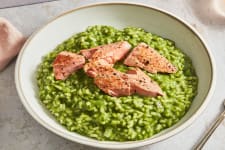A killer pizza made with wild-caught seafood will have you reconsidering all of the greasy, processed pies that you’ve consumed over the course of your lifetime. Loaded with good fats, clean protein, and pure flavors, seafood pizzas recast this beloved classic for the modern palette.
Here’s how to build a seafood pizza that will turn your pizza-loving world upside down.
Choose Your Crust
Thin crust is the way to go when you’re making a seafood pizza. A thin crust is a nice textural contrast to succulent flakes of seafood, and it should give you the perfect ratio of crust to topping.
You’ve been working on your baking skills over the past few months, right? Ambitious home cooks can make their own dough from scratch. Even a simple cracker crust can do the trick, like this no-yeast recipe from Two Red Bowls.
But there’s no shame in keeping things simple and purchasing a premade or par-cooked crust that’s ready to be adorned with your toppings of choice. This shortcut will save you a lot of time and mess in the kitchen, and also ensures that you won’t have any epic crust fails.
As an alternative, you could use puff pastry as a crust — though technically speaking, you’d be making a tart rather than a proper pizza. The puff pastry crust will be much flakier than pizza dough, not to mention super buttery. Or, if you’re in a pinch for time or ingredients, pita rounds can be transformed into personal-sized pizzas that basically are ready to eat as soon as they’re toasted and crispy.
Pick Your Base
While a marinara sauce may be the first ingredient that comes to mind as the foundation of a pizza, you might want to explore other sauce options that will underscore the clean flavors of the sea that you’ll be including in your toppings.
Something herbaceous would establish a fitting flavor profile for your seafood pizza. A basil or red pepper pesto, a light coating of a dill-cream sauce, or even simply a drizzle of a really lovely olive oil with a sprinkle of parsley can be enough to set the tone for your pizza.
Easy on the Cheese
To match the lightness of your protein, choose a cheese that adds a fresh creaminess to your pizza rather than something that will drown your pizza in cheesy flavors.
Crumbled feta or cotija, dollops of goat cheese or cream cheese — anything that’s mild is a great option to use on a seafood pizza. You can even get away with adding a modest sprinkle of shredded mozzarella to your crust, which will brown up nicely in a hot oven and might give you a little stringy cheese action when it’s hot.
Even when you don’t want to make a pizza that is remotely cheesy, we suggest topping your crust with a coating of grated parmesan. The parm will caramelize into a thin, golden crust of its own as it melts, adding a savory umami flavor (rather than outright cheesiness) to your pizza.
About That Seafood
Whichever seafood you decide to use, you generally want to cook it separately so that you can add it to your pizza when your crust is nearly done baking — basically, just so that your seafood gets warmed through. This gives you way more control over the doneness of all your ingredients, since your crust and seafood are likely going to require different cook times and temperatures.
An oil-poached fillet of fish, slow-roasted in the oven and flaked into large morsels, is perfect for pizza. Leftovers are great to use, too. We’re partial to using sockeye rather than cod or halibut for seafood pizzas, as its robust flavor won’t be overpowered by any other toppings you decide to add to your concoction. But a well-seasoned fillet of white fish can hold its own on a pizza.
Consider using shellfish, as well. This crab and shishito pizza from Saveur has us salivating, and we love the prospect of topping a pizza with garlicky gambas al ajillo made with wild Alaskan spot prawns.
Tips on Layering Up
Picking out your toppings is one of the most satisfying stages of making pizza at home. The choices are limitless, whether you’re going for classic flavors or something more unexpected. But first, there are a few things you want to keep in mind that we think will help you make the pizza of your dreams.
Remember that your pizza is only going to be in the oven for about 10 minutes or so. That means that “tougher” toppings like broccoli or kale, for example, may need to be cooked separately before being added to a raw pizza crust. Similarly, if you want to include tender greens like spinach, blanch and drain them beforehand, since they’re liable to burn at high temperatures and won’t wilt in time at lower ones.
As for raw ingredients, avoid using anything too juicy or watery to top your pizza crust before it’s cooked; that way, you’ll prevent your crust from getting soggy while it’s in the oven.
Once you’ve layered up your pizza, follow the cooking directions that go along with the crust you’re using. Check in on your pizza a minute or two before it’s supposed to be done. Is it brown enough? Do your toppings need a little more time to cook down? Adjust your cook time accordingly, and when your pizza is nearing the finish line, add your seafood to the crust for the final countdown.
Pro tip: We won’t discourage you from adding slices of fresh tomatoes to your pizza before it’s cooked, but they’re a common culprit behind a soggy crust. To troubleshoot tomatoes, you can remove the seeds and guts so that all you’re left with is the “flesh.” Or, slice your tomatoes and let them drain out on a paper towel for a few minutes before you arrange them on the crust. You might even consider slow roasting cherry tomatoes beforehand to use as a topping for your pizza.
The Finishing Touches
To finish off your masterpiece, add a sprinkling of fresh herbs, thinly sliced scallions, a handful of fresh greens, a squeeze of lemon, a drizzle of chive oil or bagna cauda, a dash of hot sauce… you get the drift. You do you.
And while you’re at it, why not pour yourself a glass of wine to wash your meal down? Red wine and pizza are a match made in culinary heaven. Yes, even when your pizza is a seafood pizza. Check out our blog post for some cardinal rules of pairing red wine with seafood.






